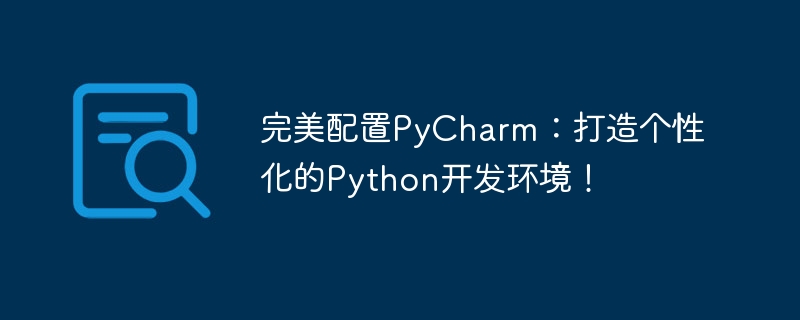

Perfect configuration of PyCharm: Create a personalized Python development environment!
As a powerful Python integrated development environment, PyCharm has rich functions and plug-ins that can help developers improve work efficiency. With appropriate configuration, we can create a personalized Python development environment to make development more efficient and enjoyable. This article will share how to configure PyCharm and provide specific code examples to help you get started quickly.
1. Install PyCharm
First, we need to download and install PyCharm. Go to the official website (https://www.jetbrains.com/pycharm/download/) to download the PyCharm version suitable for your operating system, and follow the steps of the installation wizard to install it.
2. Configure the PyCharm environment
Open PyCharm, create a new project or open an existing project, and then configure the Python interpreter. Click "File" -> "Settings" -> "Project: [Project name]" -> "Python Interpreter", select or add a Python interpreter in the pop-up dialog box.
import sys print(sys.version)
This code can output the version information of the Python interpreter used by the current project. Make sure the selected Python interpreter is the version you want to use.
In "File" -> "Settings" -> "Editor" -> "Code Style", you can set the code abbreviation Advance, code format and other styles. It is recommended to adjust according to team agreement or personal preference.
PyCharm provides a powerful code prompt function, which can greatly improve coding efficiency. Check the corresponding option in "File" -> "Settings" -> "Editor" -> "General" -> "Code Completion" to turn on the code prompt function.
PyCharm supports a wide range of plug-ins, which can be installed according to personal needs to extend functionality. In "File" -> "Settings" -> "Plugins", you can search and install various plug-ins, such as "Markdown Support", "Docker Integration", etc.
If you use a version control tool to manage code, you can configure Git in "File" -> "Settings" -> "Version Control" , SVN and other version control tools.
PyCharm integrates code inspection tools that can help detect potential problems in the code. The rules and levels of code inspection can be configured in "File" -> "Settings" -> "Editor" -> "Inspections".
Can be edited in "File" -> "Settings" -> "Editor" -> "File and Code Templates" Templates for files and codes, header comments, class definitions for custom code, etc.
3. Use PyCharm efficiently
PyCharm provides a large number of shortcut keys that can help quickly complete various operations. For example, Ctrl Alt L can format code, Ctrl Shift F can search globally, etc.
PyCharm supports fast code refactoring functions, such as renaming variables, extracting methods, etc. After selecting the code block, press Ctrl Alt M to quickly extract the method and simplify the code structure.
PyCharm has integrated debugging functions that can help find problems in the code. After setting breakpoints in your code, press the debug button to enter debug mode, step through the code and view the values of variables.
PyCharm provides integration with Git, SVN and other version control tools to easily manage code versions. Right-click in the code area to perform operations such as submitting and pulling.
Through reasonable configuration and efficient use, PyCharm can be built into a personalized Python development environment to help us write code more efficiently. I hope the above content can help you better use PyCharm for Python development.
The above is the detailed content of Perfectly configure PyCharm: create a personalized Python development environment!. For more information, please follow other related articles on the PHP Chinese website!
 How to change pycharm to Chinese
How to change pycharm to Chinese
 pycharm installation tutorial
pycharm installation tutorial
 How to solve the problem that pycharm cannot find the module
How to solve the problem that pycharm cannot find the module
 How to install pycharm
How to install pycharm
 The difference between python and pycharm
The difference between python and pycharm
 How to configure the pycharm environment
How to configure the pycharm environment
 How to install the pycharm interpreter
How to install the pycharm interpreter
 What does pycharm mean when running in parallel?
What does pycharm mean when running in parallel?




